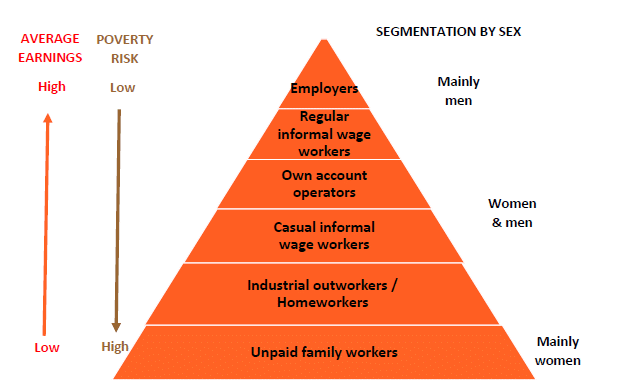Composition
Six-Segment Model by Status of Employment
In the International Classification of Status of Employment, five statuses of employment – employer, employee, own account worker, unpaid contributing family worker, and member of producer cooperative – are defined by a) the type/degree of economic risk (of losing job and/or earnings) and of authority (over establishment and other workers).
WIEGO made the case that two additional statuses of employment need to be added to the official classification: namely, casual day labourer and industrial outworker. This is because day labourers face greater economic risk than “employees” (as they face the risk of losing job and/or earnings on a daily or seasonal basis), while industrial outworkers do not exercise the same authority over their work as own account workers (as they depend on employers/contractors for work orders, product specification, raw materials, and product sales).
WIEGO tested its segmented model in six developing countries: Costa Rica, Egypt, El Salvador, Ghana, India, and South Africa. National data in each of those countries was analyzed. When segmenting by sex, average earnings, and poverty risk, it found a similar percentage of workers in different segments who are from a poor household across the six countries (Chen et al. 2005).

Causal Theory
Exclusion, Entry (Barriers), Exploitation, and Exit (“4 Es”)
The premise of the WIEGO model is that the causal theories of all four dominant schools of thought are valid – but only for certain segments of informal employment. In its “4 Es” model, WIEGO characterizes these causal theories as Exclusion, Entry (Barriers), Exploitation, and Exit, as follows:
| CAUSAL THEORY |
SCHOOL OF THOUGHT |
CENTRAL ARGUMENT |
| EXCLUSION | Dualists (ILO-WEM) | mismatch between demand for and supply of labour |
| ENTRY (BARRIERS) | Legalists (de Soto) | unreasonable regulations and hostile legal environment |
| EXPLOITATION | Structuralists (Portes) | subordination of informal units and workers to capitalist firms |
| EXIT | Voluntarists (Maloney) | calculated decision by informal entrepreneurs to exit formal system |
Different Segments Have Different Causes
Based on its research and experience, WIEGO posits that the primary driving causes of each segment of informal employment (by employment status) are as follows:
| SEGMENTS OF INFORMAL EMPLOYMENT PRIMARY CAUSAL EXPLANATION | |
| Informal Employers Informal Employees Own Account Operators Casual Day Labourers Industrial Outworkers Unpaid Contributing Family Workers |
Exit + Entry Barriers Exclusion + Exploitation Exclusion + Entry Barriers Exclusion + Exploitation Exclusion + Exploitation Exclusion + Exploitation |
Notes:
- Informal Employers may chose to exit from or face barriers to entry into the formal economy.
- Own Account Operators may be excluded from or face barriers to entry into the formal economy.
- Informal Employees + Casual Day Labourers + Industrial Outworkers tend to be excluded from the benefits associated with regular employment and exploited by employers or their contractors.
- Unpaid Contributing Family Workers are excluded from the benefits of the state (along with other members of the family business) but may also be exploited by the head of the family business or other members of the family (when it comes to allocation of labour and benefits within the family).
